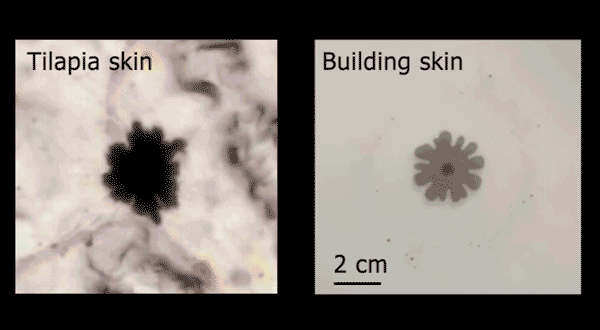Bioinspired dynamic facades to reduce buildings consumption

New study to help the facade to “behave ” as a living organism
(Sustainabilityenvironment.com) – Dynamic facades capable of changing the external appearance of buildings but also the internal microclimate. For the world of architecture this is no longer a novelty. The adaptive casings have carved out a niche in the market over time, thanks to several innovations that have reached commercial maturity. And today there are almost a hundred applications to reduce buildings consumption around the world.
Despite this, the exploited potentialities are minimal and the final applications still require several years of research and studies. The work carried out by a group of engineers from the University of Toronto is also part of this trend. The team devised a new dynamic shading system that would allow the facades to behave like a living organism. So it’s no surprise that the inspiration behind the concept is an animal. To be precise, krill, a small crustacean able to change color to protect itself from solar radiation. These tiny marine organisms are usually almost transparent, but have the ability to aggregate cell pigments to achieve a physiological and morphological change in color. In other words, they become darker or lighter as needed.
Dynamic facades, how do optophluidic cells work?

The engineers of the Canadian university have taken this concept to develop new dynamic facades bioinspired, able to reduce the buildings consumption. The prototype is composed of optophluidic cells that can switch from transparent to opaque on request, using relatively little energy. Inside the cell is contained a layer of mineral oil of 1 mm narrow between two sheets of plastic. To pigment it, a small amount of water containing a dye is injected into the cell through a connected tube, creating a sort of darker colored “bloom“. The more pigment is pumped, the greater the flowering, while a different flow changes the final shape. Low flow rates create a circular pattern, while higher speeds produce tree-like branching structures. The process is obviously reversible.
“We are interested in how confined fluids, ecological and sustainable chemicals, can be used to change the properties of materials,” says Professor Ben Hatton, who oversaw the work. “It is very versatile: not only can we control the size and shape of the water in each cell, but we can also adjust the chemical or optical properties of the dye in the water. It can be any color or opacity we want”.
Living buildings for a changing aesthetic
In addition to prototypes, the team worked with Alstan Jakubiec of the Daniels Faculty of Architecture, to construct computer models that simulate how a fully automated system based on these cells can be compared to a collection of motorized shutters or electrochromic windows.
“What we found was that our system could reduce the energy needed for heating, cooling and lighting by up to 30% compared to the other two options,” says researcher Raphael Kay. “The main reason for this is that we have much more precise control over the extent and timing of the solar shield. Our system is analogous to the opening and closing of hundreds of tiny shutters in different places and times on a facade. We can achieve this with a simple, scalable and cost-effective fluid flow”.
The group believes that the invention has potential also in the artistic field. Large array of cells could, in fact, act as pixels, creating optofluidic displays capable of producing pointillist-style artwork. In their models, the team even simulated images of famous people like Albert Einstein and Marilyn Monroe.
Hatton hopes that the idea of using dynamic facades will provide a new weapon for decarbonising buildings and reducing buildings consumption. “In the developed world, buildings are responsible for something like 40% of our emissions, which is more than any other single industry,” says the scientist. “Part of the reason is that we designed buildings to be rigid. Dynamic and adaptive ones could reduce the temperature and daylight gradients that we have to struggle with and potentially save a lot of energy. We hope that our contribution will arouse the imagination of people”.





